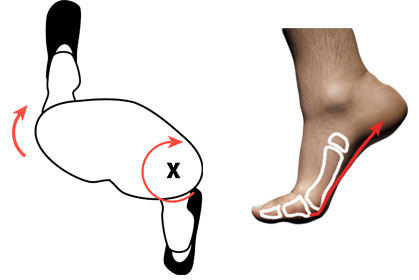|
Re-Supination:
The Lost Correction
By Edward Glaser, DPM
If one considers all the events that should normally occur during stance phase, one of them stands out as the most improbable and vulnerable to failure: re-supination from midstance to toe off. It is the only time when the foot must work against gravity and body weight during the entire gait cycle. The postural changes to the foot that begin at heel strike and end in midstance are, in contrast, aided by gravity and the body's momentum. Therefore, we are rarely concerned about sufficient pronation occurring, even though we do want to manage the speed and extent of it. But where does the foot get the power to re-wind up into supination against the crushing forces of gravity and body weight?
Re-supination is critically important, you will remember, because the foot must become relatively rigid for a propulsive gait. Even more significantly, a supinated foot posture stabilizes the First Ray against Ground Reaction Forces, allowing the First Ray (and its sesamoids) to take the majority of weight-bearing force when the heel leaves the ground. First Ray function failure becomes the mechanical etiology of many common foot ailments, such as Hallux Valgus, Metatarsalgia and Plantar Fasciitis, to name a few of the most prevalent problems.
In the healthy foot, there are two mechanisms that should be accomplishing re-supination. The first in sequence is external rotation of the grounded leg as the contra lateral leg and pelvis advance forward. The grounded leg is externally rotating to compensate for the advancing forward position of the other side. The talus then follows the rotating ankle mortise which has a supinating effect on the subtalar joint. The second mechanism kicks in as the heel leaves the ground. This calls on the windlass mechanism of the plantar fascia with the latter "reeled in" as it is pulled around the plantar aspect of the fixed, extending First MTP. The shortening plantar fascia between the medial calcaneus and the head of the First Metatarsal should have the effect of supinating the tarsus, as the tightening bowstring increases the curve of the bow of the Medial Longitudinal Arch. Theoretically, these events combine to achieve proper re-supination of the foot.

If these supinating mechanisms were adequate, though, why do we see so many flat feet that are not re-supinating? The most likely reason is innate or progressive ligamentous laxity. This laxity is most likely the result of, in addition to genetic factors, life on hard, flat floors and aggravated by excessive body weight. Sedentary living makes the secondary muscular support of the foot weaker. The foot is subject to the same kinds of breakdown that any other gravity-resisting structures suffer. Things tend to fall down rather than up, and up is the operational direction of supination in gait. As the ligaments stretch out and lose elasticity over time, pronation is favored and supination becomes more difficult. The bones of the foot are allowed more compensatory ancillary motion and do not respond as efficiently to supinating influences. The talus has more "wiggle" room in the ankle mortise so does not respond as well to leg external rotation. Joint approximation in the tarsus gaps as the ligaments elongate. The plantar fascia elongates with the flattened foot, and the windlass mechanism suffers. Reality trumps theory.
If we can agree, then, that re-supination faces special hurdles, we then have to wonder why Root et al focused so much on influencing only the heel with a post. Setting aside the inherent inefficiencies of rearfoot posting affecting foot posture (covered extensively in previous articles), there is the obvious problem of assisting re-supination with a post under a heel that is airborne after midstance. That is why I advocate MASS position as the goal of correction that is based on a functionally supinated posture for any particular foot. If we start with a supinated or MASS position of the foot, rather than a "neutral" or pronated position, we can use it as a template to give the foot the correction it needs for re-supination. Rather than employing an odd, arbitrary mix of wedges, skives, pads and bumps, we let the foot tell us what its optimally supinated posture is and we create a device that is a plantar mirror of it, delivering that posture throughout gait. It also serves as a damping mechanism for pronation after heel strike, providing that the "spring strength" is custom calibrated. This new paradigm puts the corrective emphasis on the foot where it has always been most absent: re-supination.
|